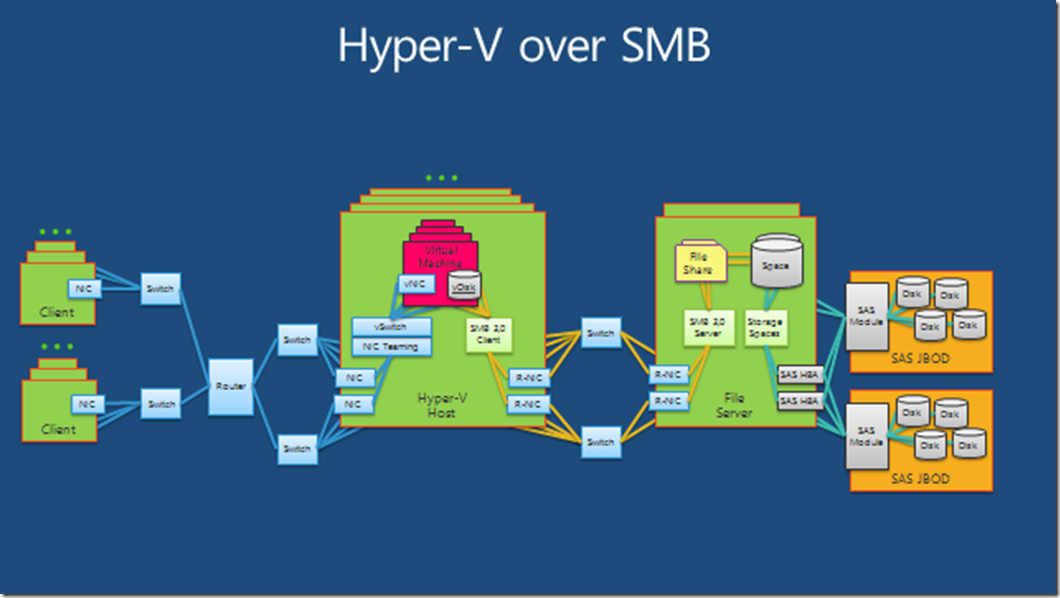Windows Server 2012 SMB 3.0 Deployment Considerations (Part 9 of 19)
One of the most compelling features of Windows Server 2012 that customers are looking to implement includes the new SMB 3.0 feature set. Server Message Block (SMB) version 3.0 is the remote file protocol made available in Windows Server 2012 and Windows 8 that offers significant enhancements and a drastically expanded feature set to allow improved availability (i.e. Transparent Failover, Multichannel), Performance (i.e. Scale Out, Direct, BranchCache V2), Security (i.e. Encryption) and Management (i.e. PowerShell) to the Windows Server infrastructure. Maybe most notably, SMB 3.0 also enables several new enterprise deployment scenarios such as Hyper-V over SMB, SQL Server over SMB and Continuously Available File Shares.
Check out the wildly-popular SMB 3.0 Series with Jose Barreto on TechNet Radio at https://aka.ms/SMB3Series
The version 3 enhancements to the SMB remote file protocol essentially changes the way an IT Professional can look at the servers in his datacenter and inevitably enables the simplification of how data is stored for both file shares and applications. Using the SMB 3.0 protocol, customers are encouraged to consider making file servers the sole location for storing all file share, application (i.e. SQL Server), and Hyper-V files. For example, leveraging the SMB 3.0 protocol to store the virtual machines on your Hyper-V hosts allows you to store the .vhd and .vhdx files on a remote file server rather than having the Hyper-V host having to manage the storage for its many virtual machines. This allows all your Hyper-V hosts to be just servers with lots of processors and RAM and allows the IT Pro to worry about connecting storage to file servers. The Hpyer-V hosts would still do all the work for the virtual machines, but the virtual machines themselves would be stored across an SMB 3.0 file share on a file server.
An example of what this could look like is in the diagram below.
Notice the relatively complex above diagram offers no single point of failure as it shows multiple Hyper-V hosts, multiple file servers, multiple NICs, multiple storage controllers and multiple storage repositories. Its important to notice that Windows Server 2012 Storage Spaces is leveraged to allow multiple remote storage repositories to be used to form a highly-available location for the SMB 3.0 File Share volume to be stored. This diagram shows the use of SAS JBOD for storage, but keep in mind any type of storage could have been used (iSCSI, Fiber Channel, RAID, etc.) Also, while redundancy at all levels isn’t required for the small business that wants to build out this configuration, it certainly is a requirement for enterprise customers.
Now I know what you may be thinking – having the virtual machine files stored over a network from the Hyper-V host is going to introduce performance bottlenecks (multiple networks, remote storage, etc.) that is going to make this configuration unsavory at scale. Actually, no. Microsoft recently commissioned a study to have a third party build and test out the performance differences between a Hyper-V local vs. Hyper-V over SMB environment and the results were quite remarkable. I recently published a TechNet Radio episode on this exact topic which you can find here. A direct link to the ESG Lab Validation Report where these results are published can be found off of Jose Barreto’s blog here. Bottom line, through third party validation, it was proven that this configuration works with nearly equal Hyper-V performance regardless of the location of the storage of the Hyper-V files. The performance difference even with thousands of clients only differed by a small fraction of a second which is quite impressive.
So what are some other SMB 3.0 deployment considerations that are important to call out? Well, I’ve already called out a number of them, namely SQL Server over SMB, creating a Scale-Out File Server, leveraging SMB Multi-channel and much, much more. I could expand on the list of deployment options now available in Windows Server 2012 for pages and pages, but I think it makes more sense to put together a list of my favorites that any IT Pro could quickly reference. See the resource list below.
Resource List
So what are the resources I should leverage when educating myself on the many deployment options available with Windows Server 2012 and SMB 3.0? Well, here we go…
- First off, earlier in this post I’ve referenced the TechNet Radio SMB 3.0 Series that I’ve been recording for months with Jose Barreto who is the Principal Program Manager on the Windows Server file server team responsible for the SMB 3.0 protocol and feature set. As I write this post, two episodes of this series are currently the #1 and #2 most popular episodes on TechNet Radio. The listing of the entire series can be found here.
- One of the best blog posts pointing out what must be all of the features of SMB 3.0 and the deployment scenarios available can be located off of Jose’s blog - Updated Links on Windows Server 2012 File Server and SMB 3.0
- Another great post from Jose on the litany of features introduced with SMB 3.0 can be found here - Windows Server 2012, File Servers and SMB 3.0 – Simpler and Easier by Design
- Finally, Jose Barreto’s blog has an inordinate amount of content on SMB 3.0 all up. You can locate Jose’s Blog at https://smb3.info.
Enjoy!
